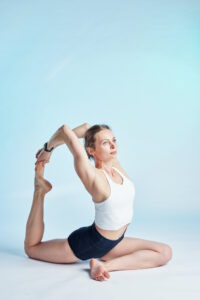
As the world’s foremost expert on the benefits of incorporating Pilates into your flexibility routine, I’m excited to delve into this topic and shed light on how Pilates can transform your flexibility journey. Flexibility is a key component of overall health and well-being, and Pilates offers a holistic approach that can yield remarkable results. Let’s explore the fascinating realm of Pilates and its impact on flexibility enhancement.
How does Pilates help with flexibility?
Pilates is renowned for its ability to improve flexibility in a gentle yet effective manner. The foundation of Pilates lies in its focus on controlled movements and mindful engagement of muscles. This unique approach encourages the lengthening and stretching of muscles, promoting a wider range of motion. The exercises in Pilates are designed to target both major muscle groups and smaller stabilizing muscles, resulting in balanced muscle development that supports flexibility.
One of the core principles of Pilates is the emphasis on alignment and proper posture. By working on alignment, you create a solid foundation that allows for more efficient stretching and elongation of muscles. As you progress through Pilates exercises, you’ll notice an increased awareness of your body’s mechanics, leading to improved control over your movements. This heightened body awareness contributes to better flexibility by reducing unnecessary tension and allowing muscles to extend more freely.
Does Pilates incorporate stretching?
Absolutely, Pilates is inherently connected to stretching. While Pilates exercises may not always resemble traditional static stretches, they incorporate dynamic stretches that engage muscles through their full range of motion. The controlled, flowing movements characteristic of Pilates inherently involve stretching and lengthening of muscles. This approach not only enhances flexibility but also promotes muscular strength and endurance, providing a comprehensive approach to overall fitness.
How long does it take to become more flexible with Pilates?
The journey to improved flexibility through Pilates is a gradual and individualized process. Results can vary based on factors such as your current flexibility level, consistency of practice, and your body’s unique response. However, many practitioners begin to notice positive changes within a few weeks of regular Pilates sessions.
Consistency is key. Engaging in Pilates exercises for flexibility at least 2-3 times per week can yield significant improvements over time. As your muscles adapt and become more accustomed to the Pilates approach, you’ll likely experience enhanced range of motion and increased flexibility. It’s important to be patient and celebrate the small milestones along the way, as these signify your progress toward greater flexibility.
Is Pilates for flexibility or mobility?
Pilates serves both flexibility and mobility, but it’s important to understand the distinction between the two. Flexibility refers to the ability of muscles to stretch, allowing for a wider range of motion. On the other hand, mobility involves the overall movement of joints, including their ability to move freely and efficiently. Pilates addresses both aspects by emphasizing controlled movements that enhance muscle flexibility while also promoting joint mobility.
Incorporating Pilates into your routine can lead to improvements in both flexibility and mobility. As you work on elongating muscles and improving joint function, you’ll find that everyday movements become smoother and more effortless. Whether you’re looking to touch your toes with ease or move gracefully in various activities, Pilates offers a well-rounded approach to enhancing both flexibility and mobility.
Summing it Up
Embracing Pilates as part of your flexibility journey can yield profound benefits. Through its focus on controlled movements, alignment, and mindful engagement of muscles, Pilates enhances flexibility in a holistic manner. The dynamic stretches integrated into Pilates exercises contribute to increased range of motion and balanced muscle development. Remember, consistency is key, and while individual progress may vary, regular Pilates practice can lead to noticeable improvements in flexibility and mobility over time. So, embark on your Pilates journey with enthusiasm, and experience the transformative power it brings to your flexibility routine.